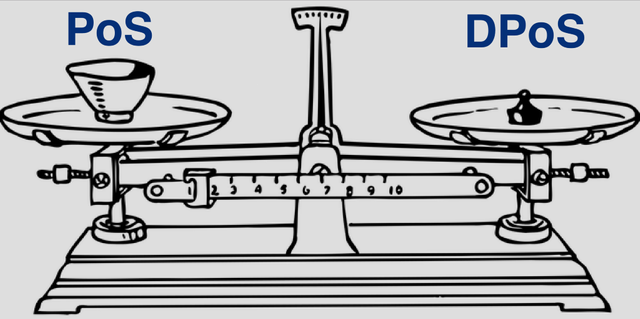Crypto Academy Season 4 Beginner Course - Task 6: Different Types of Consensus Mechanisms by @angelniro

What is the difference between PoS and DPoS? Advantages Disadvantages?
Name some Blockchain projects that use the DPoS consensus mechanism and indicate the scalability
Thanks to technological advances we can carry out transactions on the network, however we are exposed to any attack that puts these transactions at risk, which is why consensus mechanisms arise, which aim to verify and validate the transactions necessary for the creation of blocks by granting process security, which is why they have become a key tool within the blockchain. There are different consensus mechanisms among them, we can name Proof of Work (PoW), Proof of Stake (PoS), Delegated Proof of Stake (DPoS), among others, however this time we will talk about PoS and DPoS.
It was created in 2011 by Sunny King and implemented for the first time in 2012 in the Peercoin cryptocurrency, it is a consensus mechanism, currently one of the most used within the blockchain, it is based on an algorithm that is responsible for choosing the validator of the next block according to the function of the mechanisms generally related to your bet, the creators of blocks are determined randomly taking into account the number of coins of the user and the duration of those coins, that is, the greater the number of coins The longer the miner is, the higher your options will be to be selected as a validator.
The main objective of the creation of the proof of stake was to replace the proof of work (PoW), initially it was developed to optimize the work of the PoW however it became an independent mechanism; Unlike proof of work where miners need large IT equipment in proof of stake only cryptocurrencies are needed to function.
Among the technologies that implement this mechanism we have: Cardano, Ethereum, Polkadot, Tezos, among others.
How does proof of stake or PoS work?
The Proof of Stake (PoS) is a mechanism where the node that approves the addition of a new block to the blockchain is determined according to the number of coins, the validator is selected randomly and without competition, it receives a reward According to the amount of their participation, with this mechanism miners have the ability to extract and validate transactions by creating blocks according to the amount of cryptocurrencies they have.
Proof of Stake (PoS) Features
The Proof of Stake (PoS) protocol has great characteristics, among which we can mention:
- It is a technology that favors the environment since it does not need large and numerous equipment or high energy consumption for the mining process.
- It allows network members to focus their objectives and incentives on long-term network maintenance.
- In the PoS everyone can participate, it is only necessary to comply with the required quota, this allows a better decentralization and freedom to access the network.
- By having a random selection system, it gives the opportunity to those miners who have the most coins to be chosen and can verify and receive rewards.
- It enables secure fragmentation by providing the ability to create multiple blocks at the same time, increasing transaction performance.
- It offers a speed greater than that of PoW networks, this favors the use of proof of stake within the blockchain as it allows to verify large transactions in a matter of seconds.
- This type of mechanism requires that the miners' wallet is always open and connected to the internet, which generates a certain risk, they can be attacked by hackers and lose funds, however, security parameters can be used when using the PoS system.
This consensus mechanism has some advantages and disadvantages, among these we have:
Advantages
- Transaction processing is faster compared to PoW.
- It is a more efficient mechanism because it does not require large equipment or consume so much energy.
- It is a decentralized mechanism which allows greater participation
- Allows safe fragmentation.
- The creator of the next block is determined by the amount of coins the user has, in some cases they take into account the time they have had them
- It is less risky to miner attacks on the blockchain, since by affecting the compensation structure the attack would be counterproductive for the miner himself.
Disadvantages
- It is vulnerable to risk of attack by hackers since it is necessary that the miners have their wallet open.
- To be chosen as a creator of blocks they must have large amounts of money which encourages the concentration of wealth making the rich richer
- The risk of centralization is high as most of the assets are in the hands of large miners
The delegated proof of stake or Delegated Proof of Stake was created in 2014 by Daniel Larimer, it is a consensus mechanism that offers high levels of security in public blockchains, so it is very reliable, the main objective of this mechanism is avoid the centralization of the blockchain, the holders of the coins choose the delegates who have the responsibility of producing and transmitting the transaction blocks within the network and receive a reward for this, the DPoS algorithm allows the community to be in charge After electing delegates through a voting process, the voting capacity of the participants is proportional to their participation within the network.
How Does Delegated Proof of Stake (DPoS) Work?
The DPoS mechanism works in three parts:
The voting of delegates : It is the beginning of the process, the votes are carried out in real time taking into account the number of coins that the delegates have, the more coins the greater the probability of receiving votes in favor.
Creation of blocks : When the delegates are selected, we go to this stage where each of the delegates has the ability to create a block to be added to the blockchain, each delegate can generate a block successively until the cycle is completed, in this generation process delegates can validate or deny transactions and in the end receive a monetary reward for this.
Behavior of the delegates published on Blockchain : At this stage the community has the possibility of reviewing the activities carried out by the delegates, if they do not agree, the delegate can be expelled, in this way the operation of the network can be controlled.
How DPoS works
DPoS Delegated Proof of Stake Features
- This mechanism can be safely used on public blockchains.
- Its operation is based on a voting system according to the reputation and participation of users.
- It offers greater scalability within the blockchain.
- It does not need high power equipment, therefore a large energy consumption is avoided.
Advantages
- This mechanism presents a better distribution of the rewards since the users are the ones who choose the delegates, in this way the small and large users have the same possibility of being selected and earning rewards.
- The selection of the delegates is done through a voting process where all have the same probability of being selected.
- The delegate voting system is fast which translates to a notable improvement in the scalability of blockchain technology
- Less energy consumption.
- With this mechanism, transactions are faster compared to others, for example the EOS Blockchain generates 126 blocks in each 0.5 second shift.
- It allows to maximize profits, since users who have more coins have the greatest possibility of participation and creation of blocks
Disadvantages
- In this type of mechanism, users who have fewer coins do not have the same voting power as users with large amounts, which sometimes translates into failures in the voting system.
- This protocol promotes centralization since the voting system chooses users with more coins, however the blockchains that implement this mechanism implement certain rules where delegates can be eliminated if necessary.
- There is low voter participation as users with fewer coins feel that they waste their time.
- There is a greater risk of attacks since the number of users maintained by the network is lower.
| PoS | DPoS |
|---|---|
| Block creators are chosen randomly | It presents a democratic voting system to elect the block creators (delegates). |
| In the random selection process, the miners with the greatest number of coins are the ones with the highest probability of being selected. | Voting to select delegates is based on user reputation and participation. |
| Less scalability | Offers greater scalability so larger transactions can be processed per second |
| It is a decentralized mechanism where everyone is free to access the network | It is a mechanism that allows some centralization to achieve better scalability in the network, however the centralized components are transparent and can be eliminated when necessary. |
| It is used in blockchain such as Etherum, Cardano, Tezos, DASH, Peercoin, etc. | It is used in more modern blockchains such as Bitshare, Steem, Tron, EOS, etc. |
| Transactions carried out generate a commission | Transactions carried out do not generate commissions |
- Bitshare : It was the first to implement this mechanism, it is a decentralized platform, it is capable of processing 100,000 transactions per second.
- EOS : It is an operating software system based on blockchain technology, it was launched in January 2018 and uses this consensus mechanism, its scalability is 10,000 transactions per second.
- Lisk : It was created at the beginning of 2016, this platform makes it easier for companies and institutions to use the blockchain, it is based on its own chain of blocks together with its token (LSK), it has the scalability of creating one block per second, thanks to that implements the DPoS.
- Ark : It is the fastest and most scalable system that allows integration between blockchains, implements the DPoS mechanism and has 51 delegates in charge of the operation of the network, it takes 8 seconds per transaction.
- Tron : Founded in 2017 by Justin Sun, it was integrated into the Steemit Inc blockchain in 2020, its token is TRX and has a scalability of 1000 transactions per second.
- Nano : It is a cryptoactive, it was developed in 2015, it offers immediate transfers without commissions with the ability to process more than 1000 transactions.
- Steem : It is a platform and cryptocurrency that combine blockchain technology with a social network where its users are rewarded for votes according to their interaction in the communities. In steemit every 3 seconds a block is generated.
The consensus mechanisms provide security and reliability to the blockchain, although there are differences between the proof of stake (PoS) and the delegated proof of stake (DPoS) both have the same objective which is to obtain greater scalability in transactions so that the new created blocks that are added to the blockchain are valid and safe.


